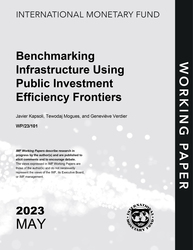
Benchmarking Infrastructure Using Public Investment Efficiency Frontiers
Benchmarking Infrastructure Using Public Investment Efficiency Frontiers
READ MORE...
Volume/Issue:
Volume 2023
Issue 101
Publication date: May 2023
ISBN: 9798400243196
$20.00
Add to Cart by clicking price of the language and format you'd like to purchase
Available Languages and Formats
| English |
Prices in red indicate formats that are not yet available but are forthcoming.
Topics covered in this book
This title contains information about the following subjects.
Click on a subject if you would like to see other titles with the same subjects.
Economics- Macroeconomics , Public Finance , Economics / General , public investment , efficiency , infrastructure , benchmarking , Benchmarking infrastructure , infrastructure output , output index , data envelopment analysis , income group , Public investment spending , Income , Stocks , Caribbean
Summary
With limited financing options, increasing investment efficiency will be a critical avenue to building infrastructure for many countries, particularly in the context of post-pandemic recovery and rising debt emanating from higher energy costs and other pressures. Estimating investment efficiency, however, presents many methodological pitfalls. Using various methods—–stochastic frontier analysis, data envelopment analysis (DEA), and bootstrapped DEA—this paper estimates efficiency scores for a wide range of countries employing metrics of infrastructure quantity and utilization. We find that efficiency scores are relatively robust across methodologies and data used. A considerable efficiency gap exists: Removing all inefficiencies could increase infrastructure output by 55 percent overall, when averaging across 12 estimation approaches—in particular, by 45 percent for advanced economies, 54 percent for emerging countries, and 65 percent for low income countries. Infrastructure output would increase by a still-sizeable 30 percent if instead of eliminating all efficiency, countries achieved the efficiency level of their income group’s 90th percentile.
Copyright © 2010 - 2025
Powered by:
AIDC



